Stop the Swedish Monkey Experiments!
From https://djurrattsalliansen.se/stoppa-primatforsoken/in-english/
The Astrid Fagræus Laboratory
At Karolinska Institutet in Stockholm, one can find the only facility experimenting on primates based in the Nordic region- the Astrid Fagræus laboratory. Despite protests from the public and despite the fact that the Swedish Board of Agriculture (Jordbruksverket) demanded that the facility with primates at the then Swedish Institute for Infectious Disease Control (Smittskyddsinstitutet) should be dismantled, the government invested money in a new primate house which was, as well, appalling from an animal welfare perspective. The new building, the Astrid Fagræus laboratory was established in 2003 and was highly criticized by the Swedish Board of Agriculture’s primate group, claiming that the new primate center “did not correspond to a modern primate center with a concern for animals.”
The Astrid Fagræus laboratory, predominantly focuses on research and animal testing related to infectious diseases, as well as diseases related to the brain. The laboratory is used by researchers at Karolinska Institutet, yet also functions as a “contract laboratory”, meaning that external researchers belonging to other institutes, universities or companies can engage in animal testing there.
Primates are not the only animals held at the facility. There are also rats, mice, rabbits, guinea pigs and pigs. Sometimes animals that are often found underrepresented in animal testing at large are also used, such as mallards, voles and shrews. The laboratory can also provide blood, plasma and serum from rabbits, guinea pigs and monkeys.
Background of the Primates
For a long time, Karolinska Institutet decided that the most optimal option would be to breed their own primates to experiment on, yet they have not had the financial or practical opportunities to do this. Primates have previously been imported from China, Indonesia, Mauritius, the Philippines, Israel and the USA.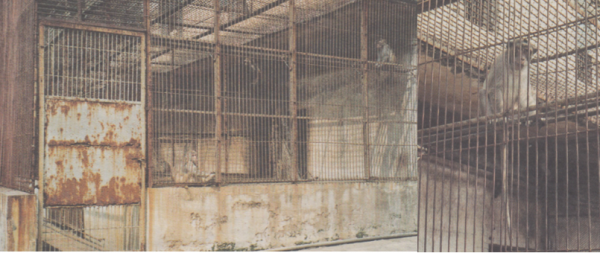
Pictures from breeder in China
At present, the monkeys are imported mainly from a large animal breeding facility that breeds tens of thousands of monkeys for the purpose of animal experimentation in laboratories. In China, there is very little transparency offered into this industry and animal welfare laws are weak.
At the breeding facility in China, a group of females can be found living together with one male. The young are taken away from their social group and their mother when they are 8 to 12 months old. In the wild, young monkeys are breastfed for 14 months and maintain close contact with their mothers for several years to come. Yet at the breeding facility, the young are placed in a large group of up to 20 individuals and when they are 3 to 4 years old, they are sent away to facilities such as the Astrid Fagræus laboratory at Karolinska Institutet through the importer/quarantine station Hartelust, located in the industrial area of Tilburg in the Netherlands.
At the facility, there are circa 1000 primates. There the primates are isolated for about 12 weeks before they are sent to Karolinska Institutet. Sometimes the primates are transported in a truck, yet at times they are known to be transported on planes to Sweden. It is a long journey for the primates who are kept in small wooden boxes during the journey. During a previous transportation of primates to AFL, four monkeys were found to have suffocated inside of their boxes in a truck.
The Primates at Karolinska Institutet
At Karolinska Institutet, cynomolgous monkeys and rhesus monkeys are experimented on. Each monkey is given a name and a number. The name is used internally when staff discuss the different animals, as well as during training. The number is used externally, for example in research reports. The monkeys have their numbers tattooed in blue ink on their stomachs. Each monkey at the facility has their own journal. Djurrättsalliansen have compiled these journals and you can access them here.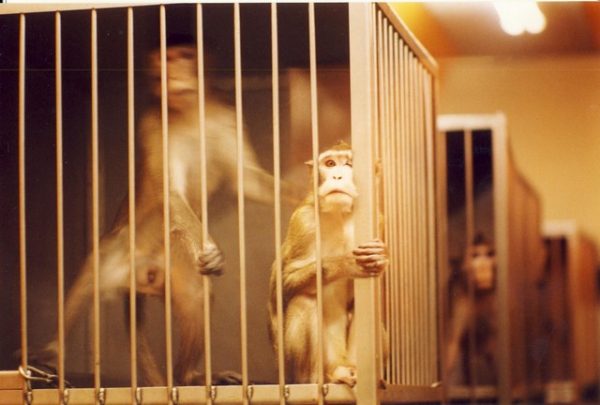
Monkeys in cages.
All of the monkeys at the Astrid Fagræus laboratory live at least two and two, and many of the monkeys are kept in larger groups. Many of the monkeys spend their lives in a stainless steel cage. Each cage is two meters high and has a floor space of two square meters. The cages are joined together in pairs so that the monkeys live together, two and two. Some of the monkeys live in larger cages. The monkeys that are not infected also have access to a glazed outdoor veneer. However, if the weather is cold, this is kept shut. In captivity, monkeys can live to be about 30 years old. The oldest monkeys at Karolinska Insititutet are 14 years old, but most of the monkeys are killed long before they reach this age.
The monkey experiments at Karolinska InstitutetA record in the form of a journal is kept for every monkey that is experimented on. In every monkey’s journal, one should be able to see what trial that specific monkey has been used in. There should also be an approval from the animal testing ethics committee, which entails that the trial is allowed to commence. In this approval, one can find a description of the trials and how the researchers responsible for these trials believe that the monkeys will be affected by them. During their time at Karolinska Institutet, it is common that monkeys used in one type of trial are later “re-used” in another. For many of the monkeys, their lives end when they are drained of blood and other bodily fluids, and their organs are taken out and used in various areas of biotechnology and medical research.
There are, at present, three experiments on primates that have been approved by Stockholm’s animal testing ethical committee and are therefore allowed to occur. They are the following:
Biomedical Basic Research and Drug Development with Medical Imaging Techniques (PET, SPECT, MRI, etc.)This trial is a continuation of previous trials of a similar nature that have been underway since at least the year 2000. The trial is approved to continue until August 15th, 2024, with the usage of up to 70 cynomolgus monkeys and 30 rhesus monkeys.
The main purpose of the trial is to examine how different receptors in the monkey’s brain function, so that one can eventually develop new trace elements and drugs for diseases such as neuropsychiatric diseases in humans (for example schizophrenia, depression and ADHD). The researchers claim that the similarities between the brains of monkeys and the brains of humans are large enough for the research on monkeys to be applicable on humans. The trial also means that the researchers will examine the distribution of drugs and trace elements in the whole body, and how different organs in the monkeys are affected by the substances that are introduced.
The trial entails that the monkeys will be encroached about nine times per year, with four to six week intervals, for the entirety of their lives. The monkeys are estimated to have a life expectancy of up to fifteen years. They are given a permanent cannula at the start of the trial and will thereafter, during each experiment, be anesthetized, transported, injected with different types of test drugs (sometimes with an observable influence on body temperature, blood pressure, heart rate, etc), have their blood removed, as well as be examined using camera technology. One trial occasion can last up to ten hours. Due to the large amount of injections that the monkeys are exposed to, earlier trials have shown that the monkeys’ veins are eventually so scarred that it becomes difficult to find a place for additional pinpricks. The monkeys used in this trial are not infected and no conclusive studies of their blood and organs are done once the trial is completed. These monkeys could therefore be allowed to retire and carry on their lives after the trials (assuming that Karolinska Institutet would be prepared to arrange for the opportunity for them to be cared for after the trial’s completion, instead of transferring them to other trials and eventually killing them through removing their organs).
Vaccine and Immunology Studies on Primates
This is a continuation of previous experiments of a similar nature that have been carried out with a similar plan since 2012, and that are now approved to continue until January 30th, 2025. Up to 120 new rhesus monkeys are allowed to be used in this trial.
The purpose of this trial is to attempt to develop different vaccine candidates that can eventually be used on humans to stop different types of infections from spreading. Before a new vaccine candidate is allowed to be tested on humans, it is tested on animals to see how different animal species react to the vaccine. At a later stage of the vaccine production, monkeys are considered to be the best “model” to conduct the tests on. This is because monkeys are considered to be genetically very similar to humans and can therefore be expected to react similarly to humans to the various vaccine candidates.
The trial means that different types of vaccine candidates (for example against the Yellow Fever, rabies and respiratory infections) will be put together in different ways in order to study how the monkeys’ immune systems react to the different combinations. The aim of course is that a vaccine should ultimately provide as much protection as possible to humans and be without any serious side effects. By testing different constituents and compositions of a vaccine on monkeys, the researchers hope to be able to exclude those compositions that would not fully work or those that would give undesired side effects. Additionally, the researchers want to examine how strong a vaccine should be, how long it can be in effect, how an individual’s immune system can handle the administration of a vaccine, as well as how it should be administered.
There are therefore many steps that are tested on the monkeys before an answer can be given as to what vaccine candidate can be used thereafter on humans. Even though it is said that the monkeys will not become infected and thereafter develop diseases, and even if they are monitored closely, there is always a risk that complications will occur. Considering that the trial involves repeated injections with different types of substances, blood and bone marrow drainage, anesthesia and so forth, the strain on the monkeys over time will be relatively great. Any chance to durable recovery will not be given. The experiments can occur for up to three years. After the trial is concluded, the monkeys will either be killed due to the researchers conducting autopsies on them, collecting and analyzing their tissues to see how their bodies have absorbed and reacted to the different vaccine candidates, or the monkeys will be “re-used” in other types of experiments.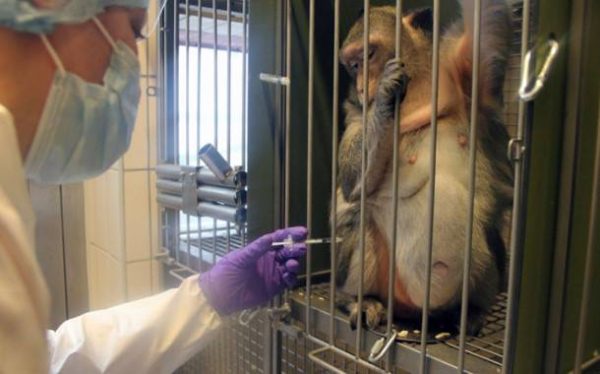
Monkey at Karolinska Institutet in Stockholm, Sweden. Photo: KI
Removal of blood, bone marrow (plus fluids), as well as organs for in-vitro studies and organ bank
This trial has been running for decades and entails that animals are drained of bodily fluids and organs are removed in order to be re-used for various types of medical research and the manufacturing of medicine. All monkeys that do not need an autopsy after other trials are often transferred to this trial purely to be drained of blood, bone marrow and fluid from the spine before their organs are removed and they are killed. How long an individual can be used in this experiment can vary greatly, depending on the monkey’s previous health status. For many monkeys, however, this entails a great amount of bone marrow, blood and other bodily fluids being drawn. When taking fluid from the spinal cord, there is a certain risk that nerve damage can occur, resulting in a circular walk or limp. This time, this trial is approved until July 11th, 2024. It is estimated that about 150 monkeys (75 rhesus monkeys and 75 cynomolgus monkeys) will be used and all of them are expected to be transferred from other trials instead of being newly purchased.
The purpose of this trial is to remove blood, blood plasma, serum and spinal fluid from the untreated monkeys for further use in diagnostic tests, method development, immunological studies, stem cell culture, and more. Clients may come from Karolinska Institutet in itself, yet may also come from external biotechnology and medicine companies looking to purchase bodily fluids and organs.
Decades of CriticismThe welfare of the primates has been criticized for decades. The facility has been run by many different actors, beginning with the State’s Bacteriological Laboratory (Statens bakteriologiska Laboratorium- SBL), and thereafter the Swedish Institute for Infectious Disease Control (Smittskyddsinstiutet- SMI). The facility has now been taken over by Karolinska Institutet.
In the late 1990s, the monkeys were living in a basement with no windows, in small wardrobe-sized cages, something that the facility was heavily criticized for. There were serious flaws found in the way that the animals were kept, and the requirements of the Animal Welfare Act were not met. The Swedish Board of Agriculture went as far as to say that they, “question SMI’s ability to even engage with animal experimentation.”
The new animal facility was ready by 2003, but even this facility is highly criticized, as several monkeys have died due to accidents at the Astrid Fagraeus laboratory. Monkeys have, for example, been squeezed to death, or have gotten stuck in interior details within the cages and therefore died. Other monkeys have died under anesthesia.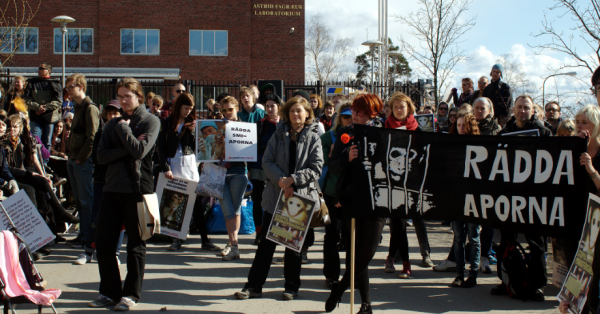
Demonstration outside the monkey laboratory in Stockholm.
EURPRIM-Net is a network composed of ten European animal experimentation facilities with primates. Karolinska Institutet is a part of this network. The idea is that these ten laboratories will together build a virtual primate center for research and breeding of primates for future experimentation.
A Happy Ending- Bacill, Bacillusk and BalooTowards the end of 2001, three monkeys were born: Bacill, Bacillusk and Baloo, as well as a fourth monkey named Bamse, about a month apart. They were described as “half siblings.” Their parents had been caught in the wild in Mauritius and had thereafter been sent to a well-known breeder known for breeding monkeys for laboratories, Mazor Farm, outside of Tel Aviv in Israel. When Bacil, Bacillusk, Baloo and Bamse, who were all born at Mazor Farm, were approaching their second birthday, they were sold to the Astrid Fagræus laboratory in Sweden. They were first flown to the importer Hartelust in the Netherlands in October 2004 and were thereafter packed into wooden boxes, loaded onto a car, and driven to the laboratory in Solna, outside of Stockholm.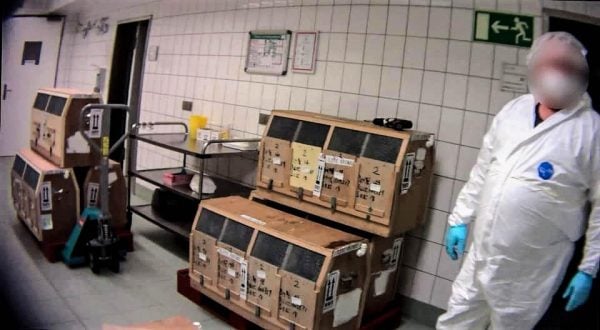
Transport boxes for primates from Hartelust at LPT, Germany Photo: Soko Tierschutz/Cruelty Free international
For many years their brains were experimented on at the Astrid Fagræus laboratory. The monkey Bamse developed diabetes and was killed. The rest were removed from the experiments in 2009, leading to many discussions as to what would happen with the monkeys thereafter. Djurrättsalliansen received information that the monkeys would most probably be killed, and therefore led a campaign encouraging the public to send letters and e-mails, appealing for the lives of the monkeys. At the same time, Djurrättsalliansen tried to find a solution for the monkeys, and together with Animal Defenders International, found an animal sanctuary in England that specialized in taking care of different kinds of monkeys. On the morning of Lucia Eve (a traditionally celebratory day in Sweden) in 2009, a plane departed from Arlanda airport. On the plane were Bacill, Bacillusk and Baloo, beginning their journey to their new life at Lakeview Primary Sanctuary in England. It was the first time in history that any laboratory primates had gotten out of the laboratory alive. On the morning of Christmas Eve, and for the first time in their lives, the trio opened, with great curiosity, their Christmas gifts filled with different goodies such as dried fruit and nuts.
Bacill, Bacillusk and Baloo enjoying christmas gifts.
To this day, the three monkeys live at Lakeview Primate Sanctuary, in a large enclosure, where they can be both indoors and outdoors, as they themselves please. They have large and healthy appetites, often preferring vegetables over fruit. As they can live to be 30 years old, these monkeys have many years ahead of them at the sanctuary.
The three rescued monkeys living their lives at a sanctuary in the United Kingdom. Photo: Craig Redmond
Support the campaign to stop the monkey experiments
🐾 Sign the petition
Help us by signing our online petition and lets get friends to sign it. You find it here.
🐾 Support our work with a donation
PLUSGIRO ACCOUNT: 42 54 11-6
IBAN: SE98 9500 0099 6042 0425 4116
BIC/SWIFT: NDEASESS
NAME OF ACCOUNT: Djurrättsalliansen
BANK: Nordea
🐾 Find out more about us
If you are interested to find out about Djurrättsalliansen (The animal rights alliance) and our campaigns against vivisection and for animals, you can find more information here.




